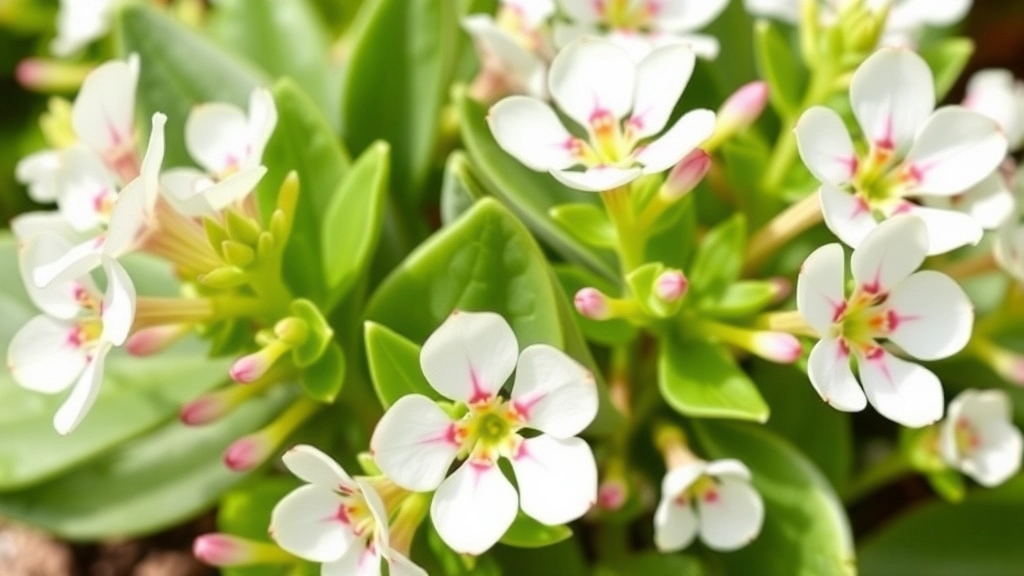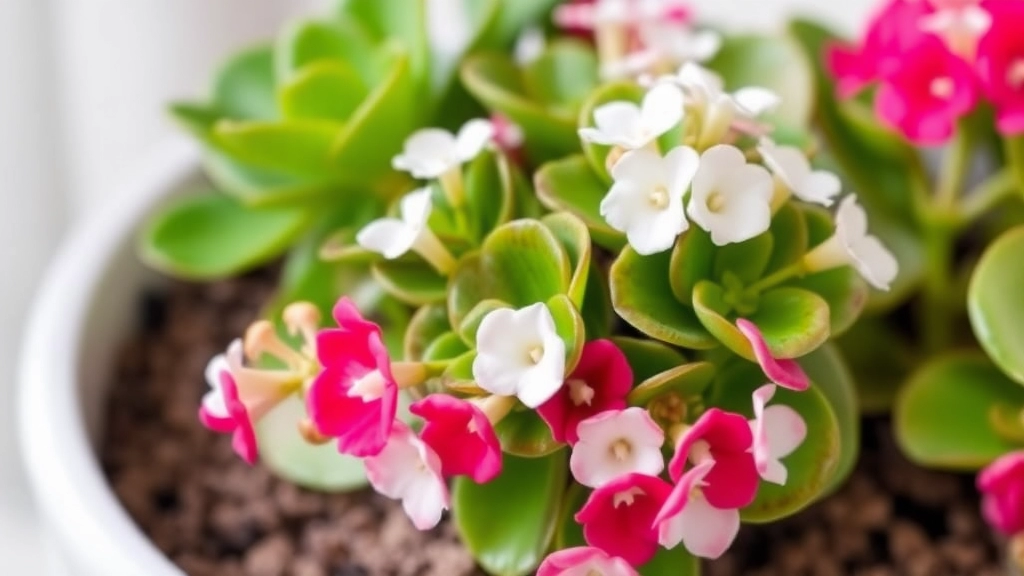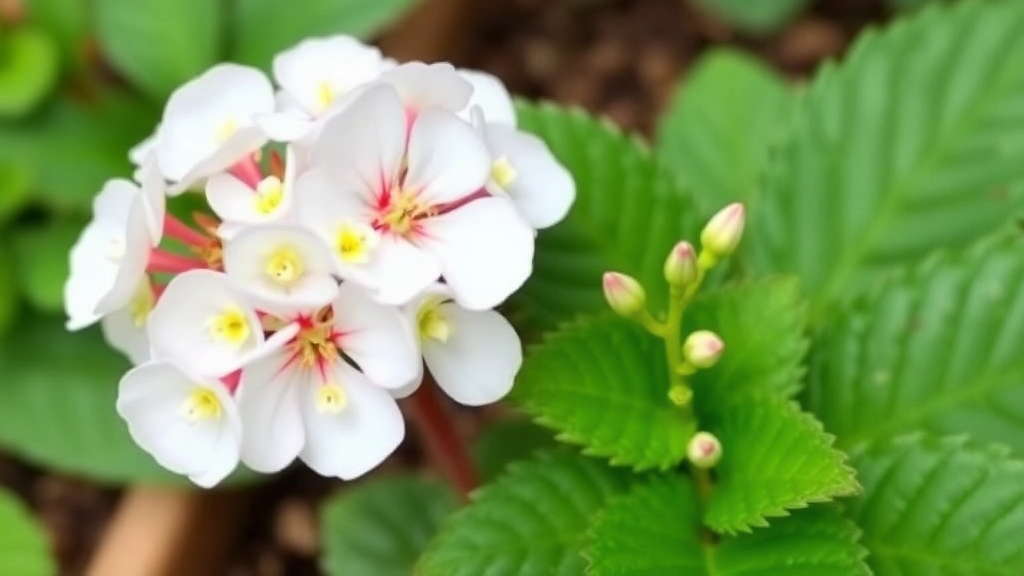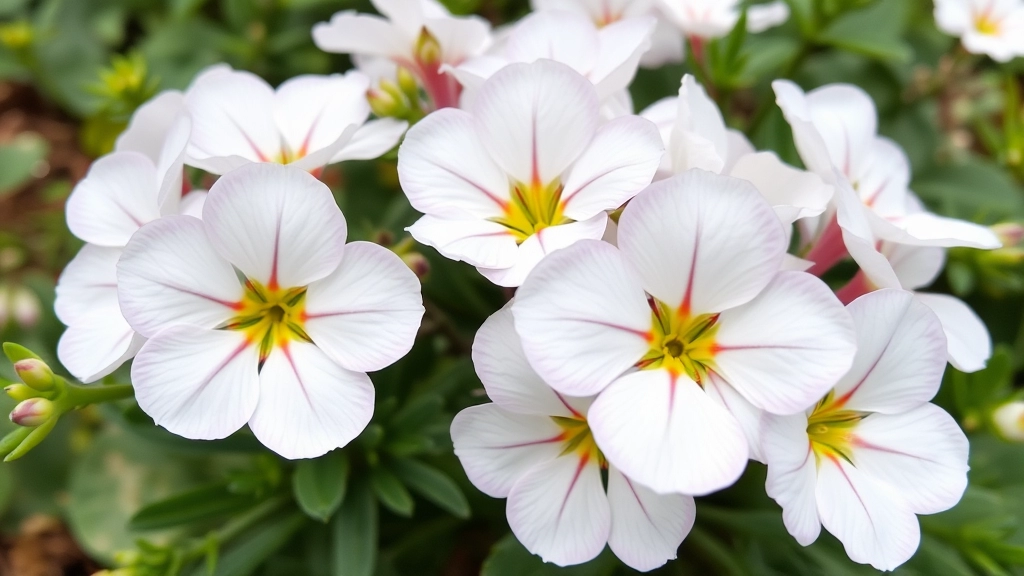Florist Kalanchoe White: A Touch of Elegance
Looking to add a touch of elegance to your home with a Florist Kalanchoe White? This stunning succulent, known for its small, long-lasting white blooms, is a favourite among plant enthusiasts. Let’s dive into how you can care for this beauty and ensure it thrives in your space.
Care Instructions
Florist Kalanchoe White is incredibly low-maintenance. Place it in bright, indirect light, water sparingly, and use well-draining soil to keep it healthy. If you’re eager to see it rebloom, make sure it gets the right light conditions.
Tips for Success
- Light: Bright, indirect light is ideal.
- Water: Water sparingly to avoid overwatering.
- Soil: Use well-draining soil for optimal health.
Whether you’re looking to purchase one or need tips on care, this guide has got you covered.
How to Choose the Right Florist Kalanchoe for Your Home
When it comes to selecting the perfect Florist Kalanchoe for your home, you might find yourself overwhelmed by the options available.
Key Considerations:
- Variety: Look for the specific type of Kalanchoe you want, such as the popular White Kalanchoe Blossfeldiana. Its stunning blooms can brighten up any space. For more tips on how to care for this variety, check out our Flowering Kalanchoe Care Guide.
- Health of the Plant: Inspect the leaves and flowers. They should be vibrant and free from discoloration or pests. A healthy plant will thrive better in your home.
- Size: Consider the space where you plan to place your Kalanchoe. Smaller plants are ideal for tabletops, while larger ones make a statement in living areas.
- Seasonal Availability: Kalanchoes are often more accessible in spring and summer. Plan your purchase accordingly to ensure you get the freshest plants.
- Local vs. Online: Decide whether you prefer to visit a local nursery or shop online. Local nurseries allow you to inspect the plant in person, while online options often provide a wider selection. If you decide to buy online, consider our guide on Buying Kalanchoe Seeds Online for the best sources and growing tips.
Essential Care for White Kalanchoe Blossfeldiana

So, you’ve got your hands on a beautiful White Kalanchoe Blossfeldiana. Now, how do you keep it thriving? It’s all about the essentials, and trust me, once you get the hang of it, your plant will thank you with stunning blooms.
Watering Wisely
First off, let’s chat about watering. Overwatering is a common mistake. Here’s what I do:
- Check the soil: Stick your finger about an inch into the soil. If it feels dry, it’s time for a drink.
- Water thoroughly: When you water, make sure it drains out of the bottom. Your plant hates soggy feet!
- Frequency: Generally, every 2-3 weeks is good, but it varies with the season.
Light Love
Next up is light. White Kalanchoes are sun-loving plants. Here’s how to give them the best:
- Bright, indirect sunlight: A spot near a window is perfect.
- Avoid harsh afternoon sun: Too much direct sunlight can scorch those lovely leaves.
Temperature and Humidity
These beauties prefer a stable environment. Aim for:
- Temperature: Between 15°C to 25°C (59°F to 77°F) is ideal.
- Humidity: They thrive in low to moderate humidity, so no need for a humidifier.
Fertilizing for Growth
To keep those blooms coming, a little food goes a long way:
- Use a balanced fertilizer: Every 4-6 weeks during the growing season.
- Dilute it: Half the recommended strength to avoid burning the roots.
When it comes to ensuring your White Kalanchoe thrives and produces stunning blooms, light conditions play a pivotal role. Are you struggling to get your Kalanchoe to flower? You’re not alone; many plant enthusiasts face this challenge.
White Kalanchoe, specifically the Blossfeldiana variety, flourishes best in bright, indirect sunlight. Here’s what you need to know:
– **Direct Sunlight**: While Kalanchoe can tolerate some direct sunlight, prolonged exposure can scorch the leaves. Aim for a balance.
– **Indirect Light**: Placing your plant near a window that receives filtered light is ideal. This encourages healthy growth and vibrant blooms.
– **Duration**: Aim for about 6 hours of light per day. If natural light is limited, consider using grow lights to supplement.
Recognizing the signs of inadequate light can help you adjust conditions promptly:
– **Leggy Growth**: If your plant is stretching towards the light, it’s a sign it needs more.
– **Poor Flowering**: Sparse blooms indicate insufficient light.
– **Leaf Discoloration**: Yellowing leaves may suggest too much direct sunlight or not enough overall light.
If you notice any of these signs, consider the following adjustments:
– **Repositioning**: Move your Kalanchoe to a brighter spot or adjust its angle towards the light source.
– **Rotation**: Regularly rotate your plant to ensure even light exposure on all sides.
– **Seasonal Changes**: Be mindful of seasonal shifts that may affect light availability, and adjust accordingly.
For more detailed tips on how to ensure your Kalanchoe thrives, you might find our [complete guide to Kalanchoe plant care](https://planthq.org/complete-guide-to-kalanchoe-plant-care/) helpful. Additionally, if you’re facing issues with your plant not blooming, check out our article on [why your non-flowering Kalanchoe isn’t blooming and tips to fix it](https://planthq.org/why-your-non-flowering-kalanchoe-isnt-blooming-tips-fixes/).
Watering Guide: Keeping Your White Kalanchoe Healthy

When it comes to caring for your White Kalanchoe, watering is one of the most crucial aspects to get right. Overwatering or underwatering can lead to problems that may hinder its growth and blooming potential.
Understanding Watering Needs
White Kalanchoe Blossfeldiana thrives in well-draining soil, which influences how often you should water. Here are some key points to consider:
- Frequency: Water your Kalanchoe every 2-3 weeks during the growing season (spring and summer). In the dormant period (autumn and winter), reduce watering to once a month.
- Soil Check: Always check the top inch of soil. If it feels dry, it’s time to water. If it’s still moist, wait a few more days.
- Watering Method: Water deeply until it drains from the bottom of the pot. This ensures the roots receive adequate moisture.
- Drainage: Ensure your pot has drainage holes to prevent water from accumulating, which can lead to root rot.
Signs of Improper Watering
Keeping an eye on your Kalanchoe’s health will help you adjust your watering routine as needed:
- Overwatering: Yellowing leaves and mushy stems are signs of too much water. Adjust your schedule and let the soil dry out between waterings.
- Underwatering: If the leaves appear shrivelled or wrinkled, your plant may need more frequent watering.
Best Soil Types for White Kalanchoe Blossfeldiana
Choosing the right soil for your White Kalanchoe Blossfeldiana is crucial for its overall health and blooming potential.
You might be wondering, “What type of soil is best for my Kalanchoe?”
Here’s what you need to know:
- Well-Draining Soil: Kalanchoes thrive in soil that drains well. This prevents root rot, which is often caused by excess moisture. A mix designed for succulents or cacti is ideal.
- pH Level: Aim for a slightly acidic to neutral pH, around 6.0 to 7.0. This range will help your plant absorb nutrients efficiently.
- Soil Components: Consider a blend that includes:
- Perlite: Improves aeration and drainage.
- Sand: Enhances drainage and mimics the plant’s natural habitat.
- Organic Matter: Such as peat moss or compost, which provides essential nutrients.
- Commercial Mixes: If you prefer convenience, look for pre-packaged succulent or cactus soil mixes available at garden centres. These are formulated to meet the specific needs of Kalanchoes.
- DIY Mix: If you’re feeling adventurous, you can create your own mix by combining:
- 1 part potting soil
- 1 part perlite
- 1 part coarse sand
Using the right soil not only supports healthy growth but also encourages vibrant blooms. For more detailed guidance, check out our Comprehensive Kalanchoe Plant Care Guide and learn how to plant Kalanchoe in a pot effectively.
How to Encourage Reblooming in Your White Kalanchoe

So, you’ve enjoyed the beautiful blooms of your White Kalanchoe, but now you’re wondering how to get those lovely flowers to return. You’re not alone; many plant lovers face this challenge. Let’s dive into some practical tips to help your Kalanchoe thrive and rebloom.
1. Prune After Blooming
- Once the flowers start to fade, don’t hesitate to prune the stems.
- Cut back to just above a leaf node to encourage new growth.
2. Adjust Light Exposure
- After blooming, your Kalanchoe needs bright, indirect light.
- Consider moving it to a spot where it can soak up the sun without direct rays burning the leaves.
3. Control Watering
- Allow the soil to dry out between waterings.
- Overwatering can lead to root rot, which is a big no-no for reblooming.
4. Fertilize Wisely
- Use a balanced liquid fertilizer every four weeks during the growing season.
- This gives your plant the nutrients it needs to produce those beautiful flowers again.
5. Temperature Matters
- Keep your Kalanchoe in a warm spot, ideally between 18-24°C (65-75°F).
- Sudden temperature changes can stress the plant and hinder blooming.
6. Provide a Dormancy Period
- After the blooming season, give your Kalanchoe a rest period.
- Cut back on water and stop fertilizing for about six weeks.
7. Be Patient
- Reblooming can take time, so don’t rush it.
- Enjoy the process and keep an eye on new growth.
Common Pests and Diseases to Watch Out for
As you care for your White Kalanchoe, it’s essential to be vigilant about potential pests and diseases that can compromise its health. Recognising these issues early on can save your plant from significant damage and ensure it continues to thrive.
Seasonal Care Tips for Indoor and Outdoor Kalanchoe

So, you’ve got your beautiful White Kalanchoe, and you’re wondering how to keep it thriving throughout the seasons.
Indoor Kalanchoe Care:
- Winter:
- Keep your Kalanchoe in a warm spot, ideally around 15-20°C.
- Reduce watering; let the soil dry out between waterings. This helps prevent root rot.
- Spring:
- Time for a refresh! Repot if needed, and start watering more regularly as the plant wakes up.
- Consider fertilising every few weeks to encourage growth.
- Summer:
- Kalanchoe loves the sun! Place it in a bright spot but avoid direct afternoon rays.
- Water more often, ensuring the soil remains slightly moist.
- Autumn:
- Gradually reduce watering as the plant prepares for dormancy.
- Keep an eye out for pests as they can be more active during this time.
Outdoor Kalanchoe Care:
- Winter:
- If your Kalanchoe is outdoors, bring it inside before the frost hits.
- Protect it from cold drafts and keep it in a sunny window.
- Spring:
- Once the danger of frost has passed, you can move it back outside.
- Prune any dead leaves or flowers to promote new growth.
- Summer:
- Ensure it gets plenty of sunlight, but provide some shade during the hottest part of the day.
- Water deeply but infrequently; let the top inch of soil dry out.
- Autumn:
- Prepare for cooler temperatures by checking for pests and diseases.
- Start bringing your Kalanchoe indoors if you live in a colder climate.
Finding the perfect White Florist Kalanchoe can feel overwhelming, especially with so many options available.
### Local Options
– **Garden Centres**
– Local garden centres often carry a variety of Kalanchoe, including the stunning white variety.
– Staff can provide valuable care tips.
– **Florists**
– Independent florists may stock White Kalanchoe, especially around holidays.
– You can often find beautifully arranged plants ready for gifting.
– **Farmers’ Markets**
– Seasonal markets frequently feature local growers who may offer unique varieties.
– This is a great way to support local businesses.
### Online Options
– **Specialty Plant Websites**
– Websites like *Etsy* or *The Sill* often feature a selection of White Kalanchoe.
– Look for sellers with good reviews to ensure quality.
– **Large Retailers**
– Sites like *Amazon* and *Home Depot* typically have a range of indoor plants, including Kalanchoe. For more information, you can check out [buy Kalanchoe seeds on Amazon](https://planthq.org/buy-kalanchoe-seeds-on-amazon-top-varieties-tips/).
– Check for delivery options and plant health guarantees.
– **Subscription Services**
– Consider plant subscription boxes that include Kalanchoe as part of their offerings.
– This can be a fun way to discover new plants regularly.
### Tips for Buying
– **Check Reviews**: Always read customer feedback to ensure you’re getting a healthy plant.
– **Look for Healthy Foliage**: Avoid plants with yellowing leaves or signs of pests.
– **Consider Shipping**: If buying online, check the shipping conditions to ensure your plant arrives in good shape. For more details on caring for your new plant, refer to this [complete care guide for Kalanchoe Flaming Katy](https://planthq.org/complete-care-guide-for-kalanchoe-flaming-katy/).
Decorating with White Kalanchoe: Ideas for Home and Garden

So, you’ve got your beautiful White Kalanchoe, and you’re wondering how to showcase it, right?
These stunning plants can brighten up any space, and I’ve got some fun ideas to help you get creative with your decor.
1. Table Centerpieces
- Place a few White Kalanchoe in a decorative pot.
- Use them as a centerpiece for your dining table.
- Pair with candles or fairy lights for an inviting atmosphere.
2. Window Sills
- Let those lovely blooms soak up the sun!
- Arrange them on your window sill for a fresh, vibrant look.
- Mix with other plants for a mini indoor garden vibe.
3. Hanging Baskets
- Use hanging baskets to create a cascading effect.
- This works great in corners or above eye level.
- It adds depth and interest to your space.
4. Outdoor Patios
- Bring your Kalanchoe outside during warmer months.
- They’re perfect for brightening up patios or balcony spaces.
- Group them with other outdoor plants for a lively display.
5. Gift Arrangements
- Kalanchoe makes for a thoughtful gift.
- Create a lovely gift basket with a potted Kalanchoe and some gardening tools.
- Add a personal note for that extra touch.
6. Mix and Match
- Combine your White Kalanchoe with other flowering plants.
- Think about contrasting colours for a striking effect.
- This creates a beautiful, layered look.
7. Seasonal Decor
- Use your Kalanchoe as part of seasonal decorations.
- For instance, pair them with autumn leaves or winter ornaments.
- They can easily transition with the seasons.
Propagating White Kalanchoe: Simple Steps for Success
Are you looking to expand your collection of White Kalanchoe without spending a fortune? Propagating your plant can be an enjoyable and rewarding process.
Why Propagate?
Not only does propagation allow you to create new plants, but it also helps you maintain a healthy parent plant by removing any leggy or overgrown stems.
Steps to Propagate White Kalanchoe
- Choose the Right Time
The best time to propagate is during the growing season, typically in spring or early summer. This ensures optimal growth conditions. - Select Healthy Cuttings
Look for healthy stems that are free from pests or diseases. Aim for cuttings that are around 3-4 inches long. - Make the Cut
Using clean, sharp scissors or pruning shears, cut just below a leaf node. This is where new roots will form. - Let Them Callous
Place the cuttings in a dry area for a day or two to allow the cut ends to callous over. This helps prevent rot when they are placed in soil. - Prepare the Potting Mix
Use a well-draining soil mix, ideally a cactus or succulent mix. This will help prevent waterlogging. - Plant the Cuttings
Insert the calloused ends of the cuttings into the soil, burying them about an inch deep. - Water Sparingly
After planting, lightly water the soil. Allow it to dry out before watering again, as overwatering can lead to rot. - Provide Proper Light
Place the pot in a bright, indirect light location. Too much direct sunlight can scorch the leaves. - Monitor Growth
In a few weeks, you should start to see new growth, indicating that your cuttings have rooted successfully.
For more detailed information on propagation, you might find this step-by-step guide to Florist Kalanchoe propagation helpful. Additionally, if you’re curious about the different types of Kalanchoe, check out our article on 150 species of Kalanchoe succulent plants.
Fertilizing Your White Kalanchoe for Maximum Blooms
So, you’ve got your stunning White Kalanchoe and you’re ready to make those blooms pop.
But how do you ensure your plant gets the nutrients it needs to thrive?
Fertilizing is key!
Why Fertilizing Matters
Just like us, plants need food to grow strong and healthy.
For your White Kalanchoe, the right fertilization can lead to vibrant blooms and lush foliage.
When to Fertilize
- Growing Season: From spring to early summer, this is when your Kalanchoe is most active.
- Frequency: Every 4-6 weeks during this period works wonders.
What to Use
- Balanced Fertilizer: Look for a balanced, water-soluble fertilizer with equal parts nitrogen, phosphorus, and potassium (like a 10-10-10 mix).
- Dilution: Always dilute your fertilizer to half the recommended strength. This prevents root burn.
Application Tips
- Water First: Give your plant a good drink before fertilizing. This helps the roots absorb nutrients better.
- Even Distribution: Apply the diluted fertilizer evenly around the base of the plant.
- Avoid Leaves: Keep the fertilizer off the leaves to prevent burning.
Signs Your Kalanchoe Needs More Nutrients
- Pale Leaves: If the leaves start to lose their vibrant green, it might be time to fertilize.
- Poor Blooming: Fewer flowers? That’s a red flag!
For more detailed care tips, check out our Kalanchoe Flapjack Paddle Plant Care Guide and learn about Winter Care Tips for Healthy Kalanchoe Plants.
FAQs About White Kalanchoe Blossfeldiana
What are the basic care requirements for White Kalanchoe Blossfeldiana?
White Kalanchoe Blossfeldiana needs bright, indirect sunlight, watering every 2-3 weeks, and a stable temperature between 15°C to 25°C (59°F to 77°F). They thrive in low to moderate humidity and benefit from a balanced fertilizer every 4-6 weeks during the growing season.
How often should I water my White Kalanchoe?
Generally, water your White Kalanchoe every 2-3 weeks during the growing season (spring and summer). In the dormant period (autumn and winter), reduce watering to once a month. Always check the top inch of soil to ensure it is dry before watering.
What kind of light does a White Kalanchoe need?
White Kalanchoe thrives in bright, indirect sunlight. A spot near a window is ideal, but avoid harsh afternoon sun as it can scorch the leaves.
How can I encourage my White Kalanchoe to rebloom?
To encourage reblooming, prune after blooming, adjust light exposure to bright, indirect light, control watering, use a balanced liquid fertilizer every four weeks during the growing season, maintain a stable temperature, and provide a dormancy period after the blooming season.
What are the signs of improper watering for White Kalanchoe?
Signs of overwatering include yellowing leaves and mushy stems, while underwatering can cause the leaves to appear shriveled or wrinkled. Adjust your watering routine accordingly.
Can I keep my White Kalanchoe outdoors?
Yes, you can keep your White Kalanchoe outdoors during warmer months. Ensure it gets plenty of sunlight but provide some shade during the hottest part of the day. Bring it indoors before the frost hits in colder climates.
How do I decorate with White Kalanchoe?
White Kalanchoe can be used as table centerpieces, on window sills, in hanging baskets, on outdoor patios, as part of gift arrangements, mixed with other plants, and as seasonal decor. They add a vibrant and fresh look to any space.
What should I do during the dormancy period of my White Kalanchoe?
During the dormancy period, cut back on water and stop fertilizing for about six weeks. This rest period helps the plant prepare for the next blooming cycle.
What temperature range is ideal for White Kalanchoe?
The ideal temperature range for White Kalanchoe is between 15°C to 25°C (59°F to 77°F). Sudden temperature changes can stress the plant and hinder blooming.
How can I prevent root rot in my White Kalanchoe?
Prevent root rot by ensuring your pot has drainage holes and by allowing the soil to dry out between waterings. Avoid overwatering and make sure excess water drains out of the bottom of the pot.
References
-
The Spruce: Kalanchoe Plant Profile
-
Gardening Know How: Growing Kalanchoe Plants
-
The Old Farmer’s Almanac: Kalanchoe
